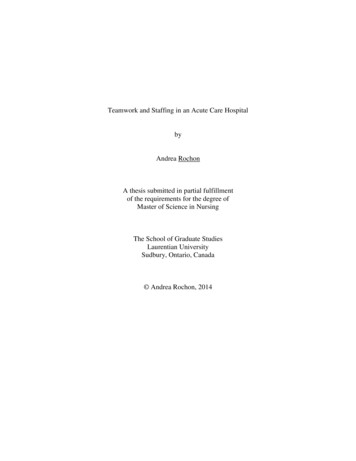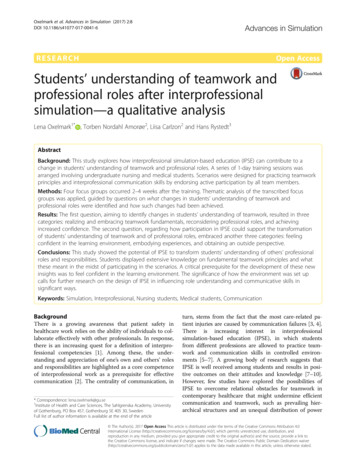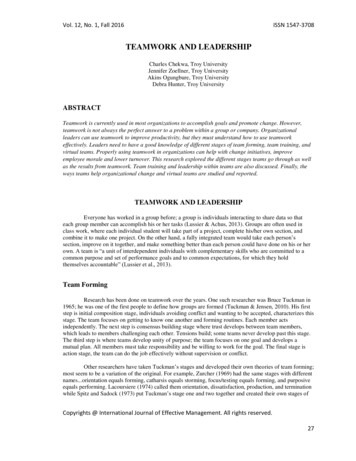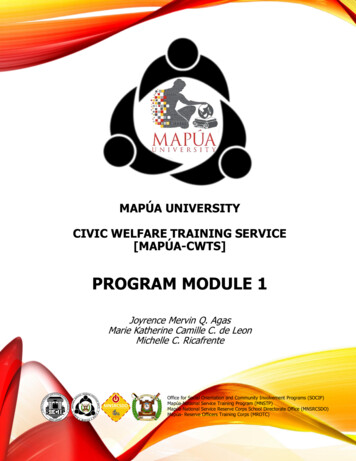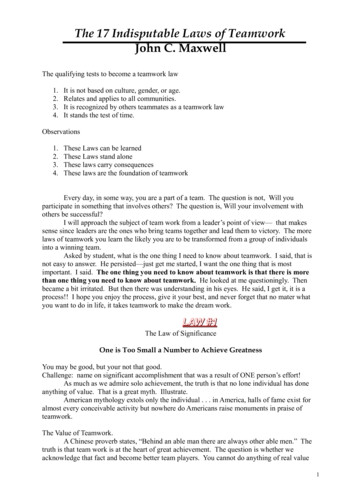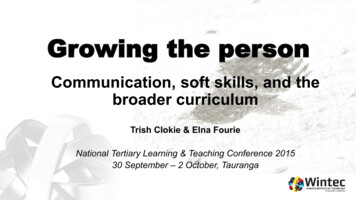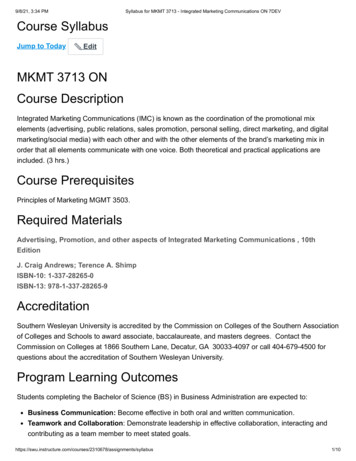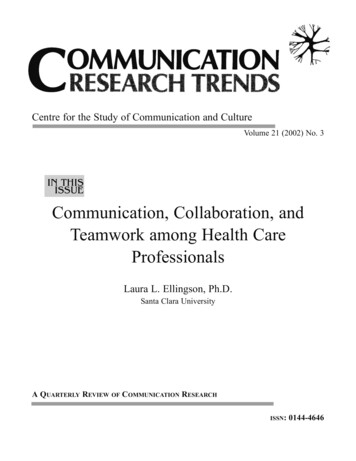
Transcription
Centre for the Study of Communication and CultureVolume 21 (2002) No. 3IN THISISSUECommunication, Collaboration, andTeamwork among Health CareProfessionalsLaura L. Ellingson, Ph.D.Santa Clara UniversityA QUARTERLY REVIEW OF COMMUNICATION RESEARCHISSN:0144-4646
Table of ContentsCommunication Research TrendsVolume 21 (2002) Number 3http://cscc.scu.edu/trendsCommunication, Collaboration, and Teamworkamong Health Care Professionals . . . . . . . . . . . . 3Published four times a year by the Centre for the Study ofCommunication and Culture (CSCC), sponsored by theCalifornia Province of the Society of Jesus.Copyright 2002. ISSN 0144-4646I. Introduction to the Fieldof Health Communication . . . . . . . . . . . . . . . . . 3II. Theoretical Approaches . . . . . . . . . . . . . . . . . . 4III. Collaboration in Heath Care . . . . . . . . . . . . . .A. Nurse-Physician Collaboration . . . . . . . . . . .B. Nurse Practitioner-Physician Collaboration . .C. Social Worker-Physician Collaboration . . . . .D. Pharmacist-Physician Collaboration . . . . . . .E. Physician-Physician Collaboration . . . . . . . .556677IV. Health Care Teams . . . . . . . . . . . . . . . . . . . . . 7A. Defining Hospital Teamwork . . . . . . . . . . . . 8B. Effectiveness of Health Care Teams . . . . . . .10C. Communication and Conflict in Teams . . . . .10D. Role Overlap on Teams . . . . . . . . . . . . . . . .11V. Perspective andSuggestions for Further Research . . . . . . . . . . .12A. Teams in Action . . . . . . . . . . . . . . . . . . . . . .12B. Informal Backstage Communication . . . . . . .13C. Power and the Culture of Medicine . . . . . . . .14Afterword . . . . . . . . . . . . . . . . . . . . . . . . . . . . . . .16References . . . . . . . . . . . . . . . . . . . . . . . . . . . . . . .17Additional Bibliography . . . . . . . . . . . . . . . . . . . .21Book Reviews . . . . . . . . . . . . . . . . . . . . . . . . . . . .22Journals Received . . . . . . . . . . . . . . . . . . . . . . . . .35Newsletters Received . . . . . . . . . . . . . . . . . . . . . .39Obituary: Rev. Jean Desautels, S.J. . . . . . . . . . . . .42Notices . . . . . . . . . . . . . . . . . . . . . . . . . . . . . . . . .432 - VOLUME 21 (2002) NO. 1Editor: William E. Biernatzki, S.J.Managing Editor: Paul A. Soukup, S.J.Subscription:Annual subscription (Vol. 21)US 45Payment by check, MasterCard, Visa or US preferred.For payments by MasterCard or Visa, send full accountnumber, expiration date, name on account, and signature.Checks and/or International Money Orders (drawn onUSA banks; for non-USA banks, add 10 for handling)should be made payable to Communication ResearchTrends and sent to the managing editorPaul A. Soukup, SJCommunication DepartmentSanta Clara University500 El Camino RealSanta Clara, CA 95053 USATransfer by wire to: Bank of America, 485 El CaminoReal, Santa Clara, California. 95050, Account 0042514510, Routing #121000358. Add 10 for handling.Address all correspondence to the managing editor at theaddress shown above.Tel: 1-408-554-5498Fax: 1-408-554-4913email: psoukup@scu.eduThe Centre for the Study of Communication and Culture(CSCC) is an international service of the Society of Jesusestablished in 1977 and currently managed by theCalifornia Province of the Society of Jesus, P.O. Box 519,Los Gatos, CA 95031-0519.COMMUNICATION RESEARCH TRENDS
Communication, Collaboration, and Teamworkamong Health Care ProfessionalsLaura L. Ellingson, Ph.D.Department of CommunicationSanta Clara UniversityEmail: lellingson@scu.eduI. Introduction to the Field of Health CommunicationHealth communication is a vital topic for researchbecause everyone either interacts with health professionals, encounters health-related messages in themedia, has suffered from a serious illness, or has experienced a loved one with a life-threatening or terminalillness (Sharf, 1993). Our experiences with health andillness are significant to our sense of self. Two journalsin the field of communication, Health Communicationand the Journal of Health Communication publishresearch exclusively on communication topics withinhealth care, public health campaigns, and relatedissues. Additionally, mainstream communication journals such as Journal of Applied CommunicationResearch and Communication Monographs, also publish articles on health communication. Journals in arange of other disciplines cover health communicationtopics, such as Health Psychology, Sociology of Healthand Illness, and Qualitative Health Research. Bothgraduate and undergraduate communication curriculain universities across the U.S. commonly includehealth communication courses, and there is a growingmarket for textbooks in the field. Three excellent introductory textbooks written by communication scholarsinclude Beck’s (2001) Communicating for betterhealth: A guide through the medical mazes, du Pre’s(1999) Communicating about health: Current issuesand perspectives and the forthcoming (October 2002)Communicating health: Personal, cultural, and political complexities by Geist-Martin, Ray, and Sharf.At the same time that professional interest andresearch is expanding, public awareness of health risksand disease prevention is at an all time high (Sharf,1993; du Pre, 1999). With the proliferation of managedcare in the U.S., patients are becoming more active intheir own care. The popular press is rife with articles ona wide range of health care issues (e.g., Strauman,COMMUNICATION RESEARCH TRENDS2001). These popular press topics (e.g., managed care,physician-patient communication) mirror health communication research areas.Health communication research began inresponse to physicians’ frustration with patients whodid not comply with physicians’ orders or recommendations. Physicians wanted to know why this was so,and enlisted the assistance of medical sociologists tostudy what strategies would be most effective in persuading patients to obey physicians (du Pre, 1999).Communication between physicians and patients continues to be one of the most researched topics withinhealth communication. Traditionally, health communication research has focused on three main areas ofresearch: physician-patient communication, healthinformation dissemination (e.g., media campaigns topromote smoking cessation, encourage early cancerscreening), and social support (Sharf, 1993). Overtime, the field developed a broader focus. The focus ofthe health communication field is now large and varied,and, in addition to traditional topics, includes researchon health care teams, collaboration within health care,the organization of health care institutions, the communication effects of managed care, communicationbetween health care institutions and members of disenfranchised groups, and transnational comparative studies of health care systems. Health communicationresearch has been, and continues to be, interdisciplinary, with researchers located in the fields of medicine,sociology, psychology, communication, anthropology,public health, social work, and nursing (du Pre, 1999).In the remainder of this essay, I explore one particular aspect of health communication research: communication among health care professionals from different disciplines in pairs, small groups, and teams.Multidisciplinary and interdisciplinary health careVOLUME 21 (2002) NO. 1 - 3
teams have become standard practice in many aspectsof health care provision, particularly geriatrics. Themajority of the research reviewed here comes fromU.S. researchers; however, I incorporate research onteams from New Zealand, the United Kingdom,Sweden, and Australia. I begin with an overview oftheoretical approaches to studying health care collaboration and teamwork. I then review literature on inter-professional collaboration between physicians andother types of health care and social services providers.Next, I explore the nature of teamwork in health care,particularly as it relates to cross-disciplinary communication and boundary negotiation. Finally, I provide aperspective on the state of research in health care collaboration and teamwork and offer suggestions for further research.II. Theoretical ApproachesTraditionally, health communication research hasbeen largely quantitative and positivist in its orientation (e.g., du Pre, 1999; Vanderford, Jenks, & Sharf,1997). Health communication research historically hasreflected a biomedical perspective that privileges thephysicians’ perspectives and puts physicians’ (notpatients’) concerns at the center of the research (Sharf,1993; Thompson, 1994). Although much work remainsquantitative with its emphasis on controlling and predicting behavior, researchers of health care teams haveintegrated a range of theoretical and methodologicalapproaches into their work.According to Sands (1993), four main approaches to studying health care teams include group dynamics, systems, collaborative or consensus, and constructivism (Sands, 1993). The group dynamics model positions a team as a small group in which norms, roles,and communication patterns are studied (e.g., Hannay,1980). Communication scholars using this approachtend to focus on decision making in groups (e.g.,Sabourin & Geist, 1990). Systems theorists see theteam as a system with subsystems (disciplines) that isembedded within a suprasystem (hospital or otherhealth care organization), with roles and responsibilities shifting over time to achieve homeostasis of thesystem (e.g., Estes, 1981; O’Connor, 1980).Collaborative/consensus approaches to understandinghealth care teams emphasize shared responsibility andconsensus building among team members (Mailick &Ashley, 1981). This approach seeks to foster decisionmaking as an egalitarian process with all membershaving input towards reaching a common goal.A broad and commonly used theory is social constructivism. Constructivist theorists propose thatmeaning is constructed through language in interaction(Berger & Luckmann, 1966; Gergen, 1994; Hacking,4 - VOLUME 21 (2002) NO. 31999). This approach to research is valuable for looking at teams because it draws attention to the complexways in which health care teams construct the meaningof their work, of the team itself, and of their patientsthrough communication about cases, research, andclinic practice (Sands, 1993). Indeed, “Communicationis not just a tool that groups use; groups are bestregarded as a phenomenon that emerges from communication” (Frey, 1994, p. x).Many communication researchers use bona fidegroup theory, which is compatible with a broad constructivist approach. Putnam and Stohl (1990) definebona fide groups as naturally occurring groups thathave stable but permeable boundaries and are interdependent with their context. Putnam (1994, p. 101)urges researchers of bona fide groups to pay closeattention to “what is covert, implicit, and assumed normal” in order to reveal the deep structures of the groupor team. Frey (1994), Poole (1990, 1994), and othercommunication scholars have championed thisapproach to enrich the conceptualization of smallgroup communication through exploration of groups inreal-life contexts, rather than researcher-constructed,“zero-history” groups. The bona fide group approach isvery useful for researching health care teams becauseof their complexity and embeddedness within the culture of the medical establishment. Lammers andKrikorian (1997) expanded upon Putnam and Stohl’s(1990) original model of bona fide groups by articulating implicit aspects of the model via their study of surgical teams. They argued that studies of bona fidegroups must involve attention to the group in its specific institutional context because a given team task ordecision “is a manifestation of much individual, smallgroup, organizational, and institutional work that goeson prior to and after [it]” (p. 36).COMMUNICATION RESEARCH TRENDS
III. Collaboration in Health CareSome level of collaboration between health careproviders is necessary in any health care setting. In hospitals, careful coordination of services between nurses,nursing assistants, physicians, and a variety of healthcare professionals (e.g., physical therapists) must occuraround the clock. In outpatient settings health careproviders may operate at varying levels of collaborationdepending upon the types of services offered. No singlediscipline or specialty can meet all of a patient’s needs.A hospitalized patient, for example, may need a physician to provide a diagnosis and treatment plan, a nurseto administer medications, a nursing assistant to helpwith bathing and toiletting, a phlebotomist to take bloodsamples, a dietitian to monitor food intake, a physicaltherapist to aid in muscle strengthening and flexibility,and a social worker to coordinate home care followingrelease. Without communication among all of these professionals, comprehensive and efficient treatment of thepatient is not possible.According to Baggs and Schmitt (1988), collaboration involves coordination of individual actions,cooperation in planning and working together, and sharing of goals, planning, problem-solving, decision-making, and responsibility. Collaboration can happenbetween two people who represent the same or differentdisciplines, or among small groups of people representing one or a range of disciplines. In general, health careproviders tend to strongly identify with their own discipline and its language, values, and practices (Furnham,Pendleton, & Manicom, 1981; Kreps, 1988) and torelate best to members of their own discipline (Siegel,1994). Collaboration may be very difficult to negotiateeffectively because of differences in disciplinary socialization. Cross-disciplinary communication can be complex for a myriad of reasons, but it also can be professionally rewarding and beneficial to patients’ (andpatients’ companions’) experiences. Although differentprofessions have some unique issues in collaboration,Nurses, pharmacists, and social workers facecomparable issues in collaborating with physicians, including a lack of acceptance by physicians of the full breadth of other professionals’roles, continuing status and gender differences,contradictory expectations regarding the autonomy of nonphysicians, and a commonlyCOMMUNICATION RESEARCH TRENDSexpressed need for physicians’ recognition oftheir competence . . . (Abramson & Mizrahi,1996, p. 271)Research on health care collaboration is very physician-centric, with most studies investigating howphysicians work with members of other disciplines; itrarely specifies how nonphysicians from different disciplines communicate with members of other disciplines, or even physicians from different specialties(Atkinson, 1995). Still, a good deal of research hasbeen conducted with the goal of improving communication between physicians and nurses, nurse practitioners, social workers, pharmacists, and, to a lesser extent,other physicians. In order to uncover some of the challenges associated with collaboration, I will begin witha brief review of findings on physicians and membersof various disciplines.A. Nurse-Physician CollaborationNurses and physicians generally do not share perceptions of their own and the others’ roles in providinghealth care (Iles & Auluck, 1990; Katzman, 1989).Stein’s (1967) classic rendering of the “doctor-nursegame” depicted dominating doctors to whom nursesmade diagnostic and treatment recommendations in asubmissive manner, such that the recommendationappeared to have been initiated by the physician. Thispervasive pattern served to reinforce the existing hierarchy that framed nurses as “handmaidens” to physicians(Prescott & Bowen, 1985). The fact that nursing is overwhelmingly female (Haug, 1988) and medicine wasalmost exclusively a male province until the last 25years reinforced this dynamic. The addition of morefemale physicians has not brought about rapid change inthe nurse-physician relationship. For example, onestudy reported that 55% of nurses surveyed found working with female physicians to be no better or worse thanworking with male physicians (Nursing 91, 1991). Thismay be due to the fact that female physicians are trainedlargely by men, according to masculine communicationnorms (Northrup, 1994; Wear, 1997).Over time, nursing roles have expanded, formalized, and come to be regarded as more autonomous intheir areas of expertise. Many nurses assert their equality and work to improve collaborative communicationVOLUME 21 (2002) NO. 3 - 5
with other professionals, particularly with physicians(Stein, 1990). Physicians often perceive attempts at collaborative practice by nurses as an invasion of theirrightful sphere of practice (Baggs & Schmitt, 1988;Michelson, 1988). Lacking clear boundaries, nurses andphysicians must continually negotiate their roles (Allen,1997; Prescott & Bowen, 1985). While roles are evolving, continuing power and economic status differencesencourage nurses to accommodate and submit to physicians (Katzman, 1989; Prescott & Bowen, 1985).Open and frequent communication is essential toimproving nurse-physician relationships (Katzman,1989; Pike, 1991; Prescott & Bowen, 1985). Quality ofrelationships between nurses and physicians appears tobe critical in lowering mortality rates in hospital intensive care units (Knaus, Draper, Wagner, &Zimmerman, 1986) and overall improvement of patientcare (Fagin, 1992). Collaboration between doctors andnurses is especially important in caring for elderlypatients (Fagin, 1992).B. Nurse Practitioner-Physician CollaborationThe position of nurse practitioner is a relativelynew one, and the negotiation of control between nursepractitioners and physicians is still very much unresolved. Physicians tend to see nurse practitioners asphysicians’ helpers or extenders who should operatebeneath the authority of physicians (Campbell-Heider& Pollock, 1987). This encourages continuation of thedoctor-nurse game which reinforces physician dominance, even though nurses at all levels hold significantinformal power and influence over diagnosis and treatment decisions (Allen, 1997; Campbell-Heider &Pollock, 1987). Recent studies demonstrate that somenurse practitioners and physicians have collaboratedsuccessfully (and cost-effectively) in providing longterm care to patients (Burl, Bonner, Rao, & Khan,1998; Ryan, 1999) and that such collaborations mayimprove efficiency of patient care in primary care practices (Arcangelo, Fitzgerald, Carroll, & Plumb, 1996).C. Social Worker-Physician CollaborationAbramson and Mizrahi (1986) define collaboration between social workers and physicians as involving “joint activity based on equality, mutual respect andshared understanding of roles” (p. 1). Mizrahi andAbramson (1994) characterize physicians’ and socialworkers’ attitudes towards collaboration as existingalong a continuum from traditional hierarchical interactions through transformational partnerships. At oneend of the continuum, traditional physicians maintain6 - VOLUME 21 (2002) NO. 3dominance in interactions, have little interest in psychosocial factors, and reluctantly accept social workers’ function of obtaining specific services. Traditionalsocial workers accept physician control and limit theirinterventions to those defined by physicians.Transitional physicians maintain an authoritativestance but appreciate social workers’ handling of psychosocial issues and assistance in making dischargeand placement decisions, while transitional socialworkers see themselves as consultants who offerresources and opinions to assist physicians in decisionmaking. Finally, transformational physicians and socialworkers perceive themselves as interdependent colleagues and willingly share responsibility and decisionmaking with each other. Since individual physiciansand social workers may view their collaboration fromany point on their continuum, interactions may bestrained because of differing expectations for behavior(Mizrahi & Abramson, 1994).Tension between social workers and physiciansremains a common problem, and collaboration often isnot successful (Abramson & Mizrahi, 1986, 1996;Hess, 1985; Schlesinger & Wolock, 1983). Abramson& Mizrahi (1996) found that physicians and socialworkers had different beliefs about critical components of collaboration, with physicians emphasizingcompetence of social workers and social workersemphasizing quality of interaction with physicians.Social workers are trained in a biopsychosocial modelof care, whereas physicians are generally taught thebiomedical model (Gilbar, 1996). Physicians havepower and high status and therefore often do not feelthe need for and are not motivated to work towardscollaboration with social workers, who are motivatedto increase their role in patient care and have a voicein decision making (Abramson & Mizrahi, 1986,1996). Social workers can promote better relationshipswith physicians by emphasizing their ability to provide important services for physicians caring forpatients (Abramson & Mizrahi, 1986). Social workersare particularly suited to cases in which there are psychosocial and cultural factors that affect delivery ofmedical care, emotionally difficult interactions such asdelivering poor prognoses, and serving as an educatorand liaison for patients’ family members (Ben-Sira &Szyf, 1992). Physicians increasingly depend uponsocial workers as insurance companies and managedcare associations require physicians to release patientsfrom hospitals quickly; social workers arrange interimcare such as rehabilitation hospitals or nursing homeCOMMUNICATION RESEARCH TRENDS
placement, or facilitate in-home care (Mizrahi &Abramson, 1994).D. Pharmacist-Physician CollaborationThe nature of the pharmacist-physician relationship makes some tension inevitable: “Actions that thepharmacists must routinely perform if they are to practice pharmaceutic care (e.g., correcting, advising,reminding, recommending, reporting) are intrinsicallythreatening to physicians’ professional identities”(Lambert, 1996, p. 1190). Aware of this dynamic,pharmacists and pharmacy students tend to use politeness and face-saving strategies to present recommendations to physicians (e.g., asking leading questionsrather than directly suggesting an alternative drug)(Lambert, 1995, 1996). Therapeutic interventions bypharmacists offering safer, more medically and/ormore cost effective drug alternatives to physicians aregenerally well-accepted and are more common inteaching hospitals than community hospitals (Greco,Mann, & Graham, 1990). Pharmacists seek to expandtheir roles within health care organizations, and physicians generally view such expansion as an encroachment on their territory (Lambert, 1995, 1996; Ritchey& Raney, 1981). Some researchers have found benefits to increased pharmacist involvement in geriatricpatient care. For example, pharmacist review of prescriptions for elderly patients improved quality ofpatient care in regards to appropriate medication useby catching possible interactions, allergies, contraindications, and over-medication (Cooper, 1985; Monane,Matthias, Nagle, & Kelly, 1998).E. Physician-Physician CollaborationCommunication between physicians is poorlyresearched; the overwhelming focus of research onphysicians has been on their communication withpatients (Atkinson, 1995). Interestingly, what researchthere is on communication between physicians oftenhas focused on the negotiation of medical mistakes,collegial control, and other negatively perceivedaspects of medical care (e.g., Bosk, 1979; Friedson,1976; Millman, 1976; Pettinari, 1988). One area thathas received significant attention is the culture of medicine and the socialization of medical students, interns,and residents into that culture by physicians (e.g.,Atkinson, 1992; Hunter, 1991). Atkinson (1995) arguesthat “biomedical knowledge is socially produced andculturally specific . . . [and] dependent upon certainfundamental features of medical culture, which is itselfproduced and reproduced through processes of socialization” (p. 46). His study of hematologists’ consultations with physicians of other specialties explicates theprocess of producing medical knowledge through communication among physicians. For Atkinson, physicians’ talk is not the means to the accomplishment ofmedical work; the talk is the work.IV. Health Care TeamsMore formally organized and regulated collaboration occurs in health care teams. Multidisciplinary andinterdisciplinary teams continue to grow in popularityin virtually all aspects of health care, particularly in thefield of geriatrics, where comprehensive assessment bya team is well established internationally as a necessaryaspect of health care delivery (Rubenstein, Stuck, Siu,& Wieland, 1991). Collaboration between individualmembers of different health care disciplines has beenincreasingly formalized with the advent in the late1970s of health care teams. Increased specializationcontributes to the need for collaboration betweenexperts in different areas of knowledge (Cooley, 1994;COMMUNICATION RESEARCH TRENDSSatin, 1994; Stahelski & Tsukuda, 1990). Health careteams have become prevalent in many aspects of healthcare delivery (Abramson & Mizrahi, 1996; Cooley,1994; Lichtenstein, Alexander, Jinnett, & Ullman,1997; Wieland, et al., 1996). Teams exist in primarycare (Hannay, 1980); developmental disability assessment (Sands, 1993), community mental health(Griffiths, 1998), long-term institutional care (Cott,1998); rehabilitation (Cooley, 1994); oncology(Sullivan & Fisher, 1995), hospices (Berteotti &Seibold, 1994); and health care education (Edwards &Smith, 1998; Interdisciplinary Health Education Panelof the National League for Nursing, 1998).VOLUME 21 (2002) NO. 3 - 7
Geriatrics is one of the areas in health care inwhich interdisciplinary collaboration on teams hasbecome commonplace. Since the 1980s, health careresearchers have drawn attention to the particularneeds, preferences, and abilities of elderly patients.The elderly are the fastest growing segment of the U.S.population, with elderly women being the majority ofthis group (Allman, Ragan, Newsome, Scoufos, &Nussbaum, 1999). Older patients are likely to havefragmented care, seeing a different specialist for eachchronic or acute condition and greatly increasing theneed for coordination of care and treatment (Beisecker,1996). Members of different disciplines workingtogether is a cornerstone of geriatric care; older cancerpatients are more likely to have more comorbiditiesand psychosocial needs than younger patients(Stahelski & Tsukuda, 1990).Geriatric teams are a particular type of teamdesigned to meet the needs of elderly patients. Geriatricevaluation teams are extremely effective at assessmentand intervention (Applegate, Miller, Graney, et al.,1990; McCormick, Inui, & Roter, 1996; Rubenstein,Josephson, & Wieland, et al., 1984). The comprehensive geriatric assessment (CGA), defined as “a multidisciplinary diagnostic process intended to determine afrail elderly person’s medical, psychosocial, and functional capabilities and limitations in order to developan overall plan for treatment and long-term follow-up”(Rubenstein, et al., 1991, p. 8s), forms the cornerstoneof interdisciplinary geriatric practice. Such assessmentand coordination of treatment and services is especially important for older patients because this populationof patients is more likely than others to have multiplehealth needs, as well as complex interactions of medical, psychosocial, and material circumstances (Satin,1994; Siegel, 1994; Stahelski & Tsukuda, 1990).Geriatric evaluation with management (GEM) programs have become common for the treatment of frail,hospitalized elderly patients (Rubenstein, et al., 1991).GEMs usually use an interdisciplinary team approachthat involves a “core” team that sees every patient andan “extended team” of professionals who can be calledin for consultation and treatment as needed (e.g., occupational therapy, psychiatry) (Rubenstein, et al., 1991).The composition, organization, and functioningof teams varies widely among institutions, medicalspecialties, and types of patient services offered.Health care teams may include a large number of loosely associated personnel or a smaller number of highlyinterdependent professionals and paraprofessionals. A8 - VOLUME 21 (2002) NO. 3few examples of team personnel from published studies include physicians, pharmacists, registered nurses,advanced practice nurses, licensed practical nurses,occupational therapists, physical therapists, respiratorytherapists, and social workers, radiology technicians,respiratory therapy technicians, as well as non-licensedpersonnel such as clerks (Jones, 1997); attendingphysician, expert nurse, clinical nurse IIIs, clinicalnurse IIs, clinical nurse residents, chief resident, juniorresident, and medical student (McHugh et al, 1996);attending physician, patient and family, consultingphysician, ORL [Otorhinolaryngology—ear, nose, andthroat] registered nurse, ORL nurse specialist,social/psychosocial worker, dietitian, speech pathologist, maxillofacial prosthodontist, research associate,and pharmacist (Sullivan & Fisher, 1995); or twooncologists, a nurse practitioner, two registered nurses,a registered dietitian, a clinical pharmacist, a licensedsocial worker, and an administrative assistant(Ellingson, forthcomingA). The team membershipvaries depending upon the type of illness for which thepatient is being treated, the resources of the particularhospital or clinic, politics, and other factors. I now turnto an exploration of conceptualizations of teamwork.A. Defining Health Care TeamworkAuthors have put forth many definitions of teamsin the health care, communication, and managementliteratures. Researchers of health care teams involvingstaff from multiple disciplines generally use the termsmultidisciplinary, interdisciplinary, transdisciplinary,and pandisciplinary to designate the type and degree ofcollaboration among team members. I find it most useful to conceive of these terms not a
other types of health care and social services providers. Next, I explore the nature of teamwork in health care, particularly as it relates to cross-disciplinary communi-cation and boundary negotiation. Finally, I provide a perspective on the state of research in health care col-laboration and teamwork and offer suggestions for fur-ther research.

